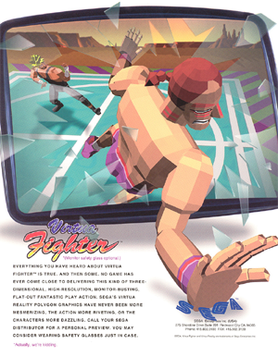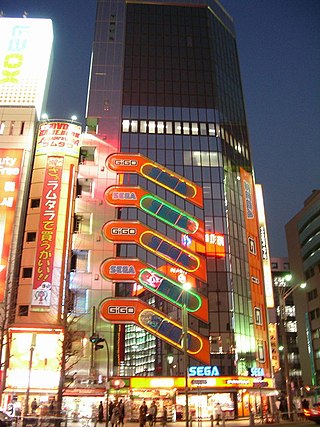
Virtua Fighter is a fighting game created for the Sega Model 1 arcade platform by AM2, a development group within Sega, headed by Yu Suzuki. An early prototype version was location tested in Japan by August 1993, before the complete game was released worldwide in December 1993. It was the first arcade fighting game to feature fully 3D polygon graphics. The game was ported to Sega Saturn as a global launch title in 1994 and 1995, and also received a port to the Sega 32X.

An amusement arcade, also known as a video arcade, amusements, arcade, or penny arcade, is a venue where people play arcade games, including arcade video games, pinball machines, electro-mechanical games, redemption games, merchandisers, or coin-operated billiards or air hockey tables. In some countries, some types of arcades are also legally permitted to provide gambling machines such as slot machines or pachinko machines. Games are usually housed in cabinets.
Racing games are a video game genre in which the player participates in a racing competition. They may be based on anything from real-world racing leagues to fantastical settings. They are distributed along a spectrum between more realistic racing simulations and more fantastical arcade-style racing games. Kart racing games emerged in the 1990s as a popular sub-genre of the latter. Racing games may also fall under the category of sports video games.

Out Run is an arcade driving video game released by Sega in September 1986. It is known for its pioneering hardware and graphics, nonlinear gameplay, a selectable soundtrack with music composed by Hiroshi Kawaguchi, and the hydraulic motion simulator deluxe arcade cabinet. The goal is to avoid traffic and reach one of five destinations before time runs out.

Sega Rally Championship is a 1995 racing game developed and published by Sega. Originally released for arcades using the Sega Model 2 board, ports were published for the Sega Saturn in 1995 and Microsoft Windows in 1997. The Sega Rally Championship simulates driving on different surfaces, with different friction properties, with the car's handling changing accordingly. As the first racing game to incorporate this feature, Sega Rally Championship is considered to be one of the milestones in the evolution of the racing game genre. It was also an early rally racing game and featured cooperative gameplay alongside the usual competitive multiplayer.

A claw machine is a type of arcade game. Modern claw machines are upright cabinets with glass boxes that are lit from the inside and have a joystick-controlled claw at the top, which is coin-operated and positioned over a pile of prizes, dropped into the pile, and picked up to unload the prize or lack thereof into a chute. They typically contain stuffed toys or other cheap prizes, and sometimes contain more expensive items like electronic devices and fashion accessories. Claw machines are also known as skill cranes, claw cranes, crane games, teddy pickers, and are known as UFO catchers in Japan due to the claws' resemblance to UFOs.

Virtua Racing or V.R. for short, is a Formula One racing video game developed by Sega AM2 and released for arcades in 1992. Virtua Racing was initially a proof-of-concept application for exercising a new 3D graphics platform under development, the "Model 1". The results were so encouraging that Virtua Racing was fully developed into a standalone arcade title.

Spider-Man: The Video Game, also known as Spider-Man, is a 1991 arcade video game developed by Sega based on the Marvel Comics character Spider-Man.

The R360 is a motion-based arcade cabinet produced by Sega. It was first released in Japan in 1990, and internationally a year later. Being short for "Rotate 360", the R360 is noteworthy for its ability to spin 360 degrees in any direction on two metal axes, allowing the player to freely move as the cabinet mimics the in-game action, including the ability to turn completely upside down. A safety bar and four-point safety harness are utilized to keep players in the seat as the machine moves. An emergency stop button is also present both inside the machine and on the attendant tower.

Super Monaco GP is a Formula One racing simulation video game released by Sega, originally as a Sega X Board arcade game in 1989, followed by ports for multiple video game consoles and home computers in the early 1990s. It is the sequel to the 1979 arcade game Monaco GP. The arcade game consists of one race, the Monaco Grand Prix, but later ports added more courses and game modes based on the 1989 Formula One World Championship.
A high striker, also known as a strength tester, or strongman game, is an attraction used in funfairs, amusement parks, fundraisers, and carnivals. It operates by utilizing the lever where one end holds a puck attached to the tower and the other end is struck by the person or contestant using a hammer or mallet. The aim of players is to ring the bell suspended on top of the tower. If the lever is struck with enough force, the puck will rise high enough to hit the bell, indicating a success. Modern versions use a spring-loaded version of the lever, while others use an enclosed striking mechanism.
Strength tester may refer to:

Champion Boxing is a 1984 boxing sports video game developed and published by Sega for the SG-1000, and later ported to the arcades, only in Japan and Europe. It was Sega-AM2 founder and leader Yu Suzuki's debut creation, as well as that of Rieko Kodama. In 1985, a successor of Champion Boxing titled Champion Pro Wrestling was released in the arcades, and ported to the SG-1000 and the MSX home computer the same year. However, this is a professional wrestling game instead of a boxing game.

A fortune teller machine is a type of amusement automaton, which upon receiving credit gives out a card with a prediction of the reader's future. This is typically given by an automaton. They could be found in penny arcades, and can be seen in modern video arcades and amusement parks.
Electro-mechanical games are types of arcade games that operate on a combination of some electronic circuitry and mechanical actions from the player to move items contained within the game's cabinet. Some of these were early light gun games using light-sensitive sensors on targets to register hits, while others were simulation games such as driving games, combat flight simulators and sports games. EM games were popular in amusement arcades from the late 1940s up until the 1970s, serving as alternatives to pinball machines, which had been stigmatized as games of chance during that period. EM games lost popularity in the 1970s, as arcade video games had emerged to replace them in addition to newer pinball machines designed as games of skill.

A love tester machine is a type of amusement personality tester machine, which upon receiving credit tries to rate the subject's sex appeal, love abilities or romantic feelings for someone. Many love testers measure the moisture on the skin surface of the subject's hands by electrically testing the skin conductance and rates accordingly. Others measure the temperature of the skin. However, some machines just use a random generator. Love meters could be found in penny arcades, and can be seen in modern video arcades, amusement parks, in bars and restaurants. Such vending machines are for amusement purposes only and do not actually give a real result. Nintendo, before entering the video game industry, released their own handheld love tester.

Periscope is an electro-mechanical arcade shooting submarine simulator. Two companies developed similar games with the name. The first, initially called Torpedo Launcher, was designed by Nakamura Manufacturing Co. and released in Japan in 1965, as the first arcade game Masaya Nakamura built. Sega Enterprises, Ltd. also built and released Periscope in Japan in 1966, as one of its first produced arcade games.

An arcade game or coin-op game is a coin-operated entertainment machine typically installed in public businesses such as restaurants, bars and amusement arcades. Most arcade games are presented as primarily games of skill and include arcade video games, pinball machines, electro-mechanical games, redemption games or merchandisers.

SegaWorld London was an indoor theme park located inside the London Trocadero in London, England. The venue opened in September 1996 and operated as a joint-venture between Chorion, then-owners of the Trocadero, and Sega. At 110,000 square feet, it was Sega's flagship location in Europe, became the first Sega theme park outside of Japan, and was claimed to be the largest indoor theme park in the world. The park was short-lived, lasting only three years in operation following poor reviews from launch and sustained business model management issues.






















